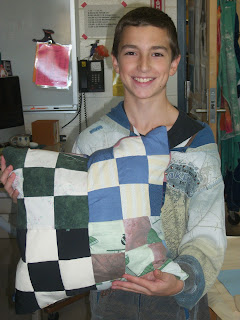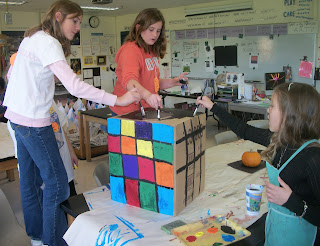"S", a 6th grader, wanted to try quiltmaking. First he decided on the pattern (9-patch) and the size of each quilt square. I suggested he make a cardboard template so each piece he cut would be uniform in size. We reviewed a running stitch and how to tie a knot, discussed the fact that most quiltmakers sew with a ¼” seam, and he started in.
The first 9-patch was sewn by hand.
Next, I suggested he might want to try the sewing machine. The next three 9-patches were sewn by machine and assembled into a group of four. The quilt started to look like a good size for a pillow, but time was quickly running out – the quarter was almost over.
I brought in my rotary cutter and cutting mat, and a transparent ruled guide so "S" could cut fabric patches more quickly. The sewing machine provided its own kinds of lessons, like running out of bobbin thread, necessitating learning how to wind a bobbin.
There are only three more days before the end of the quarter – I’m not sure if the quilt/pillow will be done in time. We are negotiating now for afterschool/recess/study hall time when a few more seams can be sewn and stuffing can be stuffed.
Speaking of stuffing – I was not sure what "S" would use to fill this special pillow – it is quite large by classroom standards, and will take a lot of stuffing.
Last night I an email from a parent: “I am doing some cleanup and I have a bag of new pillow fill that I don't need… Before I throw that away, I thought I should ask you if you can use that fill. If so, I can send the bag to school…”
What luck!
Thanks to the parents who continue to stock the art larder, with all the things that are just what we need!
FINISHED!
















